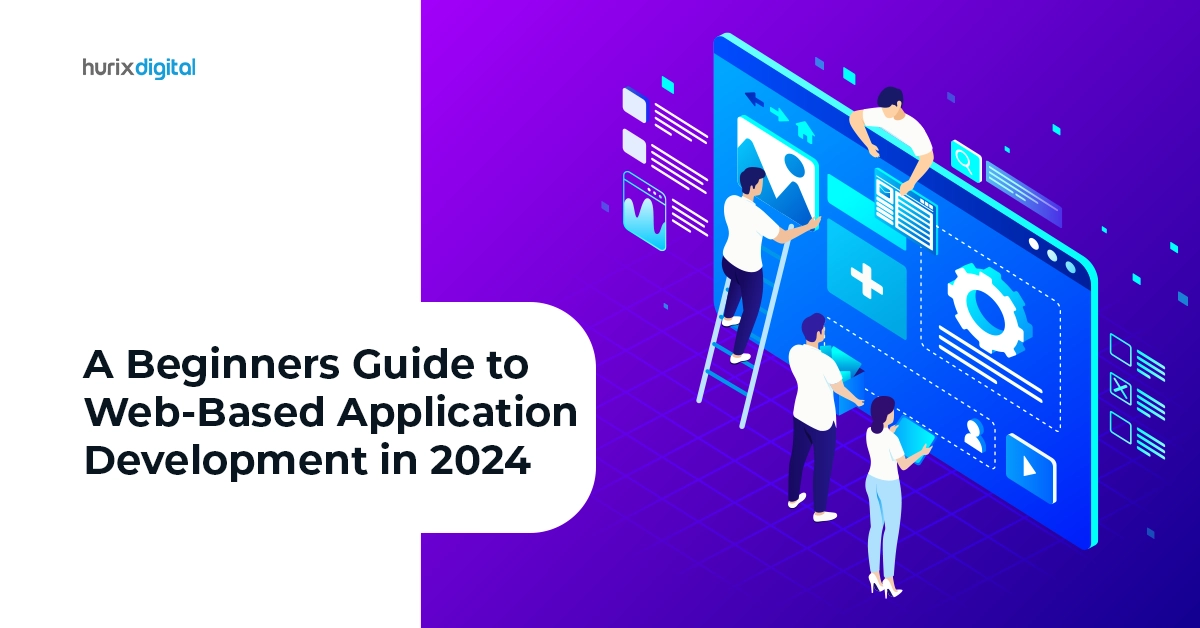A Beginners Guide to Web-Based Application Development in 2024
First impressions count: 50% of consumers judge a business by its website design. This shows how important it is to have a well-developed web application.
Whether you are an entrepreneur with a bright idea, a student curious about the digital world, or someone looking to upskill, understanding the basics of web-based application development is a valuable skill. In 2024, the technology landscape continues to evolve, and staying updated with the latest trends is crucial.
In this post, we will break down the Web application development process into its essential components, revealing the nuts and bolts behind every click and interaction. Let’s explore!
Table of Contents:
- Web Application Development: Explained!
- Popular Web Applications to Check Out in 2024
- Web Application Benefits
- Web Application Development Process
- Conclusion
Web Application Development: Explained!
Web applications, or web apps, are the dynamic engines that drive innumerable online experiences. It blends the accessibility of web pages with the power of software applications, enabling users to perform tasks, access information, and collaborate seamlessly through their web browsers.
Here is a breakdown of key concepts:
- Building Blocks: A web application is constructed using core web technologies like HTML (structuring content), CSS (styling), and JavaScript (adding interactivity).
- Data Mastery: They effectively store and manage data within databases or files, enabling users to create, read, update, and delete information (CRUD operations).
- User Focus: Web application prioritizes user experience, delivering intuitive interfaces and seamless interactions within the browser.
- Server-Side Power: While user experiences unfold in the browser, web apps often rely on server-side processes for complex tasks and data management. Web Based Application Development is the art of creating these digital experiences.
Popular Web Applications to Check Out in 2024
Here are the popular names you need to check out in 2024:
1. Hurix Digital
Hurix Digital optimizes your Web application development process with expert consultation and forward-thinking technologies. With its help, you can develop bespoke applications to address your evolving market requirements on this market automation platform.
Be it creating MVPs for startups, a scalable mobile application for an SME, or robust enterprise applications, users may leverage its proficiency in custom iOS and hybrid app development for seamless multi-platform deployment. Users can also elevate their existing website by conducting a thorough usability audit and implementing performance optimization strategies.
2. Mailchimp
Mailchimp is a comprehensive web application that merges a robust marketing automation platform with a user-friendly interface streamlining complex tasks. Developing web apps that are mobile-friendly is seamless, with pre-designed templates and no coding required.
3. Google Developer Tools
Google’s comprehensive suite of tools seamlessly guides developers through the web application development lifecycle, from concept to deployment and beyond. Debug like a pro with Chrome DevTools, build cross-platform marvels with Android Studio, and seamlessly collaborate with Google Workspace.
Also Read: Equalsense: Your Partner for AI-Powered Web Accessibility Solutions
Web Application Benefits
Here are the advantages of a tailor-made web application:
1. Rapid Deployment
A web application excels with its lightning-fast launch. Forget lengthy app store reviews or cumbersome desktop installations. Simply share the URL to take your app live. This agility and flexibility give web apps a clear edge over slower deployment options.
2. Seamless Access
Gone are the days of device dependency or restricted locations. Users, whether employees or customers, can seamlessly reach your tools from any web browser, desktop, or mobile, fostering seamless workflows and convenient service delivery.
Whether hot-desking, switching devices, or browsing on the go, your web application is just a click away, empowering productivity and engagement across diverse user scenarios.
3. Enhanced Convenience
Downloading and maintaining multiple apps can be cumbersome, cluttering phone storage and impacting battery life. A web application offers a refreshingly lightweight solution. Accessible directly through any web browser, it eliminates the need for download hassle and provides instant access from any device.
This convenience translates to higher engagement and user satisfaction, as frictionless access empowers individuals to utilize your services effortlessly across devices and contexts. Unless a specific feature requires a native app, prioritizing Web-based Application Development allows you to cater to user preferences, foster positive brand perception, and ensure your tools are readily available at their fingertips.
Web Application Development Process
Web Based Application Development involves several intricate processes, each building upon the last. Understanding the key steps is crucial for those venturing on this exciting journey.
Here is an overview of the eight pillars of web application development.
1. Defining Target Audience
Here, you sculpt the bedrock of your project, defining its purpose, goals, and target audience.
- Why? Pinpoint your purpose. Is it a self-promotional, informational, or an e-commerce platform?
- What? Establish your goals. Do you aim to boost brand awareness, generate leads, or drive sales?
- Who? Identify your ideal user. Craft a vivid picture of your target audience- their needs and desires.
This information-gathering phase forms the blueprint for your web application development process. You can confidently navigate the process with a clear vision, ensuring your website resonates with your intended audience.
2. Planning Phase
It is time to map out the pathways within your web application. When developing web apps, devote time to planning to reap the rewards of a well-organized, user-friendly website. You have 50 milliseconds to make a good first impression on visitors to your site.
Make sure you visualize the user’s journey, outlining each step they undertake to achieve their goals. Create a blueprint of your website’s structure, detailing every topic and subtopic. Anticipate user actions and design intuitive interactions that guide them effortlessly toward their desired outcomes.
3. Crafting a Wireframe or Prototype
Translate your workflow into a visual blueprint. Wireframing sketches the web application structure and interactions, aligning your vision with user needs.
4. Sharing Prototype for User Feedback
Presenting your prototype to your target audience opens a valuable dialogue, paving the way for crucial feedback and refinement. Actively listen and iterate your design, incorporating user insights to enhance the overall experience.
5. Constructing the Web Application
Database
Define the essential data elements and their respective data types. Next, construct a robust database to house and manage this data effectively.
Frontend
Mirror your validated wireframe/prototype using HTML, CSS, and JavaScript. Also, employ frontend frameworks to streamline Web Based Application Development and enhance user experience.
Backend
Craft the logic and functionality that powers your web application. Also, implement HTTP endpoints to facilitate CRUD operations (create, read, update, delete). Next, manage user authentication and authorization and serve the front end to users, ensuring seamless interaction.
6. Choosing the Right Tools
Building your web application is akin to choosing the right tool for the job. For instance, constructing a simple blog might necessitate a lightweight framework like Django, while crafting a complex social media platform might require the scalability and robust features of Ruby on Rails.
Carefully assess the features and functionalities for building a thriving web application, wielding the tools that align perfectly with your project’s unique demands.
7. Comprehensive Testing
Seamlessly integrate testing throughout the web application development process, employing manual and automated methods. Assess functionality, security, usability, compatibility, and performance. Uncover and address issues early, ensuring a smooth and secure user experience.
8. Hosting and Launching Your Web Application
Secure a domain name, select a cloud hosting provider, and embrace CI/CD tools to seamlessly transfer your web application from your local machine to its online home. Witness your creation come to life, accessible to users across the globe.
Also Read: Key Features and Capabilities of Adobe Experience Manager
Conclusion
Creating your web application from scratch offers ultimate flexibility, empowering you to tailor every line of code to your vision. However, this path demands significant time and expertise.
Hurix Digital offers custom mobile application development solutions that blend intuitive design with technology expertise, ensuring apps resonate with your audience and drive business results. With our expertise, you can leverage the benefits of custom mobile application development without the need to start from scratch.
Contact us for more details!

SVP & Head – Hurix Technology Solutions
Global Delivery head with 25 years of working experience in NYC investment banks and fintech companies. Hands-on technology delivery management and program management, accountable for stakeholder relationships, Strategic roadmap, P&L, Revenue growth, Account Management, and employee satisfaction.









